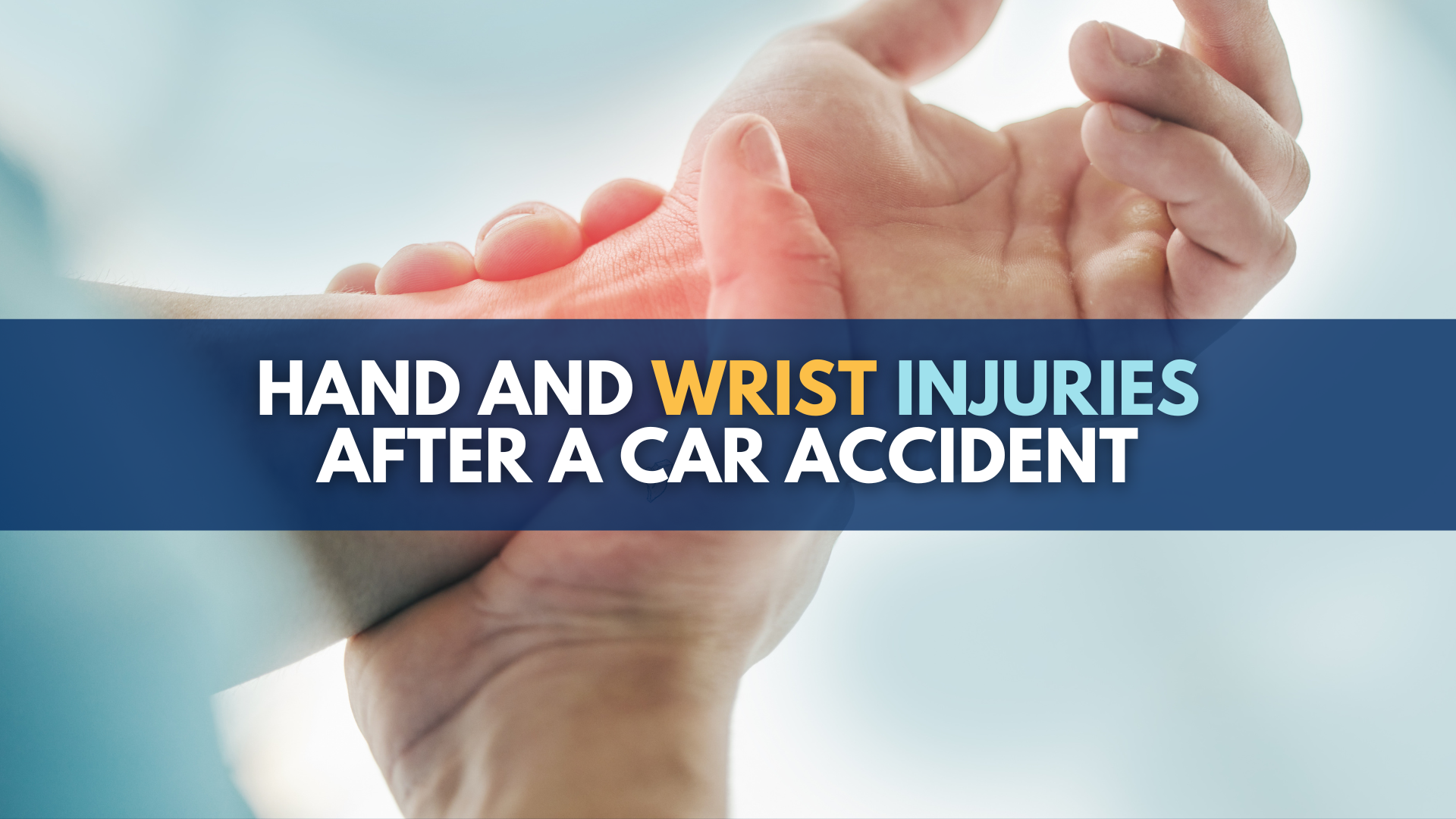Hand and wrist injuries after a car accident are common and very disruptive. They include fractured bones, torn ligaments, dislocations and sprains, which can prevent people from caring for themselves and returning to work. Treatment often includes immobilization, rehabilitation, physical therapy and surgery.
To try to appreciate how serious and debilitating a hand injury after a car accident or a wrist injury after a car accident may be, think about how often you use them in the course of any given day. We use our hands for nearly everything when it comes to our own personal hygiene, including showering, dressing, brushing our teeth, and toileting. Try putting on clothes, cooking, and taking care of young children.
Hand and wrist injuries after a car accident – which are a very common because of the violent jarring people undergo in a crash when they are gripping a steering wheel or reaching out to brace themselves after being rear-ended – will often result in significant disruption to how we live our lives.
What to do for hand and wrist injuries after a car accident
If you suffered hand and wrist injuries after a car accident, follow these steps:
- Get diagnostic imaging immediately: An x-ray will image bone and fractures. A CT scan or an MRI is better at imaging connective tissue injury that can show ligament tears and ruptures to the hand or wrist. As an injury lawyer, I am always amazed how many people have fractures and broken bones in their hands and wrists, but they are told to take aspirin and OTC medication because so many primary and family doctors do not send them for imaging right away. As a general rule, the sooner a person can get the necessary and appropriate medical care and see the appropriate medical specialist, the sooner they can get back to hopefully making a full recovery. The key with hand and wrist injuries is to get that diagnostic testing as soon as possible.
- Get a referral to a medical specialist who focuses on hand or wrist injuries. This can be an orthopedic surgeon or a physical medicine and rehabilitation doctor in the beginning. A specialist is more likely to refer you for diagnostic testing because an orthopedic surgeon cannot treat you until they have the appropriate diagnostic imaging to diagnose what type of hand or wrist injury you have. The appropriate diagnostic testing will enable your doctor to then prescribe the best course of physical therapy or treatment for you and to make the appropriate referrals for you.
- Early documentation always makes it easier to avoid future legal and medical problems with your own insurance company. Early medical documentation, such as documenting the pain and symptoms you are having in an emergency room or as soon as possible with your family doctor, will help to prove to a health insurance company or a No-Fault insurance company that the cause of your hand injury or wrist injury was from a car accident. If it does turn out to be a more serious injury, you’ve documented this right away. This helps to avoid many of the problems that as an auto accident lawyer I routinely see with insurance companies denying an injury is from a car crash. Failure to document early on leads skeptical and cynical insurance adjusters to question the causal relationship to your car accident and often leads to a claims adjuster refusing to pay for necessary medical treatment. Early treatment and medical documentation create a close temporal relationship between the event (your car accident) and your injury that insurance companies will want when they are getting bills for necessary medical care.
- Showing a clear temporal relationship between a motor vehicle collision and the documentation of treatment for a condition or injury also makes it easier to get a full and fair legal settlement for your hand or wrist injury after a car accident when it is caused by another driver’s carelessness or negligence behind the wheel. Delays in documentation and treatmentoften makes it harder for your attorney to get a reluctant insurance company to pay for a full and fair legal settlement for your injury.
- Don’t try to “tough it out”: This is tied into the point I made above. The main reason people delay is because they think it will go away, they don’t want to “complain,” they are worried about the cost of an ambulance or a visit to the emergency room, or they think with over the counter pain analgesics it will all go away within a few short days or weeks. What happens more often than not is a hand or wrist injury that they thought would be a relatively minor problem becomes worse and becomes more serious. Just like with most injuries involving fractures, tears, and ruptures, these injuries to the hand and wrist injuries may result in lifelong disabilities and chronic pain if you don’t get needed medical treatment right away.
- Talk to an attorney who is experienced at helping people injured in car accidents. Most experienced lawyers have helped people who have previously suffered hand and wrist injuries after a car accident. The initial call is always free so at the very least you will be informed as to what your insurance company is responsible to pay and what medical help and wage loss you are entitled to. An attorney can also help you review your medical records as well as the treatment and care you’re receiving to make sure bills are getting paid and to help you assess what your case might be worth if your pain and disability was caused by another driver’s negligence or carelessness.
- Tell your own No-Fault auto insurance company about your hand and wrist injuries after a car accident. If you live in Michigan, make sure to include this in your application for No-Fault benefits, which is also referred to as your “written notice of injury” – which must be given to your No-Fault auto insurance company “within 1 year after the accident.” (MCL 500.3145(1) and (4))
- Do not sign any settlements, releases, or waivers related to your car accident: Until you have talked with an experienced car accident attorney who is looking out for your interests, do not sign any settlements, releases, or waivers that are presented to you by your auto insurance company, the at-fault driver’s auto insurer or any other insurance companies or persons.
How to make a claim
In Michigan, you start your claim by filing an application for No-Fault benefits with the responsible auto insurance company, according to the No-Fault law’s “priority” rules. The No-Fault insurer will pay for your medical bills and your lost wages if you cannot return to work.
Can I sue for hand and wrist injuries after a car accident?
Yes. You actually have two potential lawsuits.
If your auto insurance company refuses to pay for – or cuts-off – No-Fault benefits related to the hand and wrist injuries after a car accident that you have suffered, then you can sue for unpaid, overdue medical bills, attendant care, medical mileage, replacement services and lost wages because your health conditions have prevented you from returning to work.
You can also sue the at-fault driver who caused the car accident for the pain and suffering and additional compensation as a result of your injuries.
Additionally, you may be able to sue the at-fault driver for other economic damages, such as excess and future medical bills and lost wages.
Causes of hand and wrist injuries from car accidents
Many people suffer hand and wrist injuries after a car accident because there are so many opportunities during a crash for these to occur:
- People use their hands to brace themselves for impact, which results in intense pressure on bones, muscles, ligaments and tendons
- People put their hands in the air to protect their faces, resulting in their hands and wrists colliding with an exploding airbag, glass shards from the windshield, the dashboard, a door, an intact window or the steering wheel
- A driver’s hands may get caught in the steering wheel and twisted as the steering wheel is spun around
Symptoms
If you’re experiencing any of the following symptoms, then you should immediately seek medical attention because you may have suffered serious hand and wrist injuries:
- Pain is always the most common. Most of the pain is localized in the affected hands, fingers and/or wrists but radiation and nerve entrapment means the pain can also be diffuse and traveling up and down the extremity.
- Stiffness and difficulty in flexing or straightening your fingers and wrists
- Loss of or limited range of motion
- Numbness in your hands
- A burning or tingling sensation
- Swelling
- Loss or lack of grip strength
- Bruising
- Discoloration
Types hand injuries and wrist injuries after a car accident
It is common for people injured in a crash to suffer a hand injury after a car accident or a wrist injury after a car accident. Those injuries may include:
- Wrist fractures
- Broken fingers
- Broken hand bones
- Crushed bones
- Bruising
- Puncture wounds
- Joint dislocations
- Torn ligaments
- Amputations
- Wrist sprains
- Torn tendons
- Carpal tunnel syndrome
Diagnosis and Treatment
To diagnose whether you have suffered any type of hand injury after a car accident or a wrist injury after a car accident, your doctor will ask about your symptoms, conduct a physical examination and likely order diagnostic testing such as X-rays and/or MRI scans.
Treatment for hand and wrist injuries may include medication, immobilization (with a splint or cast), physical therapy, physical rehabilitation and/or surgery (reduction or fixation).
Need help? Call the attorneys at Michigan Auto Law
If you have suffered hand and wrist injuries after a car accident and would like to speak to an experienced attorney, call toll free anytime 24/7 at (248) 353-7575 for a free consultation with one of our attorneys. You can also get help from an experienced accident attorney by visiting our contact page or you can use the chat feature on our website.




